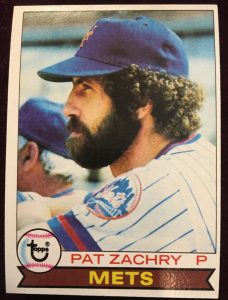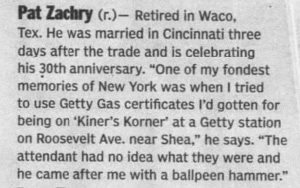As soon as you understand that a manager is going to try to “stay away” from using the relievers he relies on most, you also understand you’re going to need either a spit-ton of runs from your lineup or a comparable amount of innings from your starting pitcher. By the middle of the sixth inning on Saturday in Cincinnati, once it became clear the Mets’ starter was done, you understood the five runs the Mets had scored to that point, along with the three-run lead the Mets were holding, might be insufficient if your goal was victory.
And it wasn’t. Luis Severino gave Carlos Mendoza five gutty innings, which is to say one of them, the second, was a mess that did not quite spiral into something worse. The admirable work Luis — I’m not yet at the “Sevy” stage — put into extricating himself from the bases being loaded after two runs were home paid off in the short term, but almost guaranteed the long term wouldn’t be long enough. After 99 pitches through five, Severino was done.
The Mets led, 5-2, which was swell, given that the Mets hadn’t scored as many as five runs in a game in a week, but here came the “B” team out of the bullpen to back up the departed starter. Granted, the “A” team at any given moment might give you pause, and it’s quite possible that soon enough some pitcher on the “A” team might be relegated and a corresponding arm on the “B” team might be promoted, but for now, the vaunted Circle of Trust is real. For now, after so much recent usage of Drew Smith, Brooks Raley, Adam Ottavino and Edwin Diaz, Bob Murphy’s traditional ninth-inning instructions to fasten our seat belts carried extra resonance, and it was only the sixth.
Jake Diekman, one of our savvier offseason gets, per the assessment of those who make those pronouncements, came out of the pen with twelve outs to go. Two quick outs ensued. Great. Then Diekman walks Elly De La Cruz, hits Spencer Steer, and we’re antsily adjusting our shoulder harnesses. Pinch-hitter Stuart Fairchild singles to make it 5-3. Then there’s a steal of second that spawns a steal of home when nobody in road gray executes with big league precision, and it’s 5-4. Diekman squirms out of further trouble in could-have-been-worse fashion, yet you know in your bones it’s going to be worse.
It gets there, in the eighth, the second inning of work for Yohan Ramirez, whose seventh was effective. You wish for a reliever who can calmly deliver two solid innings and keep registering zeroes. It’s not impossible. Reed Garrett clamped down on the Tigers for three the other day (meaning he wasn’t available, either). Ramirez’s introduction to Mets fans was his taking one for the team by taking aim at the area behind Rhys Hoskins in the season’s first series. He heroically served a suspension. He was back to do something of greater value: get three goddamn outs and deliver the ninth inning intact to whoever was going to let Edwin rest.
Preservation of Diaz swiftly moved down the chain of priorities once the Reds and the eighth got through with Ramirez. Eight games into the season, it’s fair to call the bottom of the eighth Saturday a prototypical 2024 Mets defensive inning. Pitches missed when they needed to land. Fielders missed when they needed to grab. Bounces were unfriendly. And a big blow detonated. Without having the intestinal fortitude to pick apart the gruesome details, the tenuous 5-4 Met lead Ramirez was tasked with steering into the ninth transformed rather inevitably into a 9-5 deficit. The Met offense stirred in the ninth to add a run to its previously encouraging total, but the eighth and maybe the sixth had already told the tale.
New manager, new relievers, same problem in contemporary baseball, specifically contemporary Met baseball. Even when you have relievers you trust, you can’t send them out there every single day, yet you almost have to, because nearly every single day, starting pitchers thrill you if they get through five innings. Jose Quintana didn’t quite finish six on Friday night, a good outing, but an outing that led to calling on Smith and Raley and Ottavino and Diaz. Each of them had pitched on Thursday as well. The fan who’s been watching forever yearned for a Turk Wendell or a Roger McDowell to simply get up, get warm, get into the game and get the Mets through however many innings remained. Managers, whether they’re old hands like Buck Showalter or fresh faces like Carlos Mendoza, don’t do that sort of thing anymore. Also, it used to be unusual to have to get anybody cranking before the seventh. Contemporary baseball, Met or otherwise, operates differently.
One necessarily comes to appreciate a pitcher like the late Pat Zachry even more against this tableau. Zachry, who pitched for the Reds and the Mets, died on Thursday a little shy of his 72nd birthday, following illness and personal tragedy. He was traded to New York on June 15, 1977, a date that still lives in infamy for Mets fans, though not because of anything related to the pitching or persona of Pat. You don’t replace Tom Seaver on the New York Mets in the middle of a season. You just hope to succeed him and that your best will occasionally surpass adequate.
To say Zachry was no Seaver is an exercise in obviousness. There was only one Tom Seaver, especially on the Mets. But Pat Zachry as Pat Zachry was pretty darn good. There’d be nights and stretches where you didn’t forget Tom, but you were happy to root for Pat. He didn’t make the All-Star team by accident in 1978 and he didn’t rate the Opening Day start merely by default in 1981. In tandem with Craig Swan, Zachry made us think, “OK, at least we still have some bona fide starting pitching.” You wished he’d stayed in one piece more often, because when he was healthy, he’d give you length and quality and confidence, the last of those elements too often lacking on the Mets clubs of his era.
 No, no Tom Seaver, but go check out a few all-time career leaderboards where Met pitching is concerned. The tall Texan remains in the Top 25 in innings pitched and games started and ranks thirteenth in both complete games and shutouts. Complete games? What are those? Between 1977 and 1982, Pat Zachry defined the concept on a recurring basis, and every time he finished what he started, it meant one more day when Joe Torre or George Bamberger didn’t have to worry about who would have to be used in the sixth or seventh or eighth or ninth. The manager had his answer out there on the mound.
No, no Tom Seaver, but go check out a few all-time career leaderboards where Met pitching is concerned. The tall Texan remains in the Top 25 in innings pitched and games started and ranks thirteenth in both complete games and shutouts. Complete games? What are those? Between 1977 and 1982, Pat Zachry defined the concept on a recurring basis, and every time he finished what he started, it meant one more day when Joe Torre or George Bamberger didn’t have to worry about who would have to be used in the sixth or seventh or eighth or ninth. The manager had his answer out there on the mound.
 Most importantly, beyond statistics, Pat adjusted to life in a big city that was never on his radar, maintained good humor about some less than ideal professional circumstances (competitive intensity notwithstanding) and came across as a warm and decent soul to those who had the pleasure to get to know him even a little. That phrase about two seemingly contradictory things being true at the same time comes to mind: the Tom Seaver trade never should have happened, and we were lucky to have Pat Zachry.
Most importantly, beyond statistics, Pat adjusted to life in a big city that was never on his radar, maintained good humor about some less than ideal professional circumstances (competitive intensity notwithstanding) and came across as a warm and decent soul to those who had the pleasure to get to know him even a little. That phrase about two seemingly contradictory things being true at the same time comes to mind: the Tom Seaver trade never should have happened, and we were lucky to have Pat Zachry.







Looking back, the Mets got the best they could get in the Seaver trade. Zachry was pretty good, Henderson almost won Rookie of the Year, and Flynn was one of the best fielders in baseball.
And you have to be happy for Seaver, in retrospect, as he never would have gotten his 300 wins had he stayed with the Mets.
Nice piece. Pat was a decent guy.
Wasn’t Zach’s fault he wasn’t Tom Seaver. And at the time my 13-year-old self felt devastated but also thought that if we were losing my then-hero, we were getting a guy coming off a ROY year. He never quite lived up to that but at times he was pretty decent.
Pitchers are not trained to pitch deep into games. Few managers younger than Buck Showalter would even know how to nurse a starting pitcher through the 7th, 8th and 9th. I don’t know how that’s going to change.
In the meantime, one solution would be to have different pitch clock rules, different mound visit rules, maybe even a different minor league option procedure, for starting pitchers. A league without a supply of dominant, healthy starting pitchers, is like an NFL with no healthy superstar quarterbacks. And just like the NFL has extra rules to protect QBs, baseball should have extra rules to protect starters.
I’m surprised at how few pitch count violations there are. For example, a pitcher could conserve his energy by taking a pitch count violation on an 0-2 count, bases empty, to a bottom-of-the-order hitter. A pitcher could also give himself a breather by throwing over to first, especially when he knows that the man on base is not the type of player who would attempt to steal many bases.
Max Scherzer was toying around with some of these concepts during the beginning of Spring Training 2023. Then he stopped. I’m not sure what happened.
I was heartbroken when this trade happened, but I’m more heartbroken now.
But in retrospect, it’s quite an honor to be traded for Tom Seaver. Sad to hear, 71 is not old.
I was 12, and it was quite the event when Seaver came back to Shea later that year to take on the Mets. Jerry Koosman was Seaver’s mound opponent that afternoon.
Seaver won, and he and Koosman were BOTH on Kiner’s Korner. That’s how great TV and the Mets were back then.
I don’t mean the team was great, of course. What was great was the relationship between the team, TV, the fans, and the announcers.
There was a genuine warmth between the announcers and the team and the fans, a relationship not comparable in any way to the cold fish in the booth today, of Cohen, Darling, and Hernandez. And of course, that utter fool, Steve Gelbs.
It’s a statement more on the lack of taste on the part of the fans, rather than on the Mets, or TV, or streaming, or gambling, or anything. If we have the attention spans of gnats, well, that’s what they ALL will serve up.